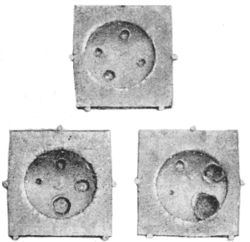Among experiments made to demonstrate the resistance of structures to attack by a mob was one upon a safe twenty-nine inches cube, with walls four inches and three quarters thick, made up of plates of iron and steel, which were re-enforced on each edge so as to make it highly resisting, yet when a hollow charge of dynamite nine pounds and a half in weight and untamped was detonated on it a hole three inches in diameter was blown clear through the wall, though a solid cartridge of the same weight and of the same material produced no material effect. The hollow cartridge was made by tying the sticks of dynamite around a tin can, the open mouth of the latter being placed downward, and I was led to construct such hollow cartridge for use where a penetrating effect is desired by the following observations:
In molding the gun cotton at the torpedo station, as stated above, a vertical hole was formed in each cylinder or block in which to insert the detonator,  Holes produced in Iron Plates by bored Gun Cotton. and in the final press a steel die was laid upon the cake so that an inscription in letters and figures was forced upon it. This inscription was indented in the cylinders and was raised upon the surfaces of the blocks. When the gun cotton was fired untamped, in testing it, the cylinder or block was usually placed with the inscribed face resting on a polished iron plate or iron disk, and after firing, if the gun cotton had detonated it was invariably found that not only was a vortexlike cavity produced below the detonator, but that the inscription on the gun cotton was reproduced on the iron plate, and, what was most singular, when the inscription was indented in the gun cotton it was indented in the iron plate, and when the inscription was raised on the surface of the gun cotton it was reproduced raised on the surface of the iron plate. In experimentally investigating this phenomenon I eventually soaked several cylinders in water, so that I could bore them without danger, and then bored holes of various diameters and depths in them, until in the last instance I bored a vertical hole an inch and three quarters in diameter completely through the cylinder. These wet cylinders were each placed on a similar iron plate, a similar dry disk was placed on each as a primer, and they were successively fired, when it was found that the deeper
Holes produced in Iron Plates by bored Gun Cotton. and in the final press a steel die was laid upon the cake so that an inscription in letters and figures was forced upon it. This inscription was indented in the cylinders and was raised upon the surfaces of the blocks. When the gun cotton was fired untamped, in testing it, the cylinder or block was usually placed with the inscribed face resting on a polished iron plate or iron disk, and after firing, if the gun cotton had detonated it was invariably found that not only was a vortexlike cavity produced below the detonator, but that the inscription on the gun cotton was reproduced on the iron plate, and, what was most singular, when the inscription was indented in the gun cotton it was indented in the iron plate, and when the inscription was raised on the surface of the gun cotton it was reproduced raised on the surface of the iron plate. In experimentally investigating this phenomenon I eventually soaked several cylinders in water, so that I could bore them without danger, and then bored holes of various diameters and depths in them, until in the last instance I bored a vertical hole an inch and three quarters in diameter completely through the cylinder. These wet cylinders were each placed on a similar iron plate, a similar dry disk was placed on each as a primer, and they were successively fired, when it was found that the deeper
